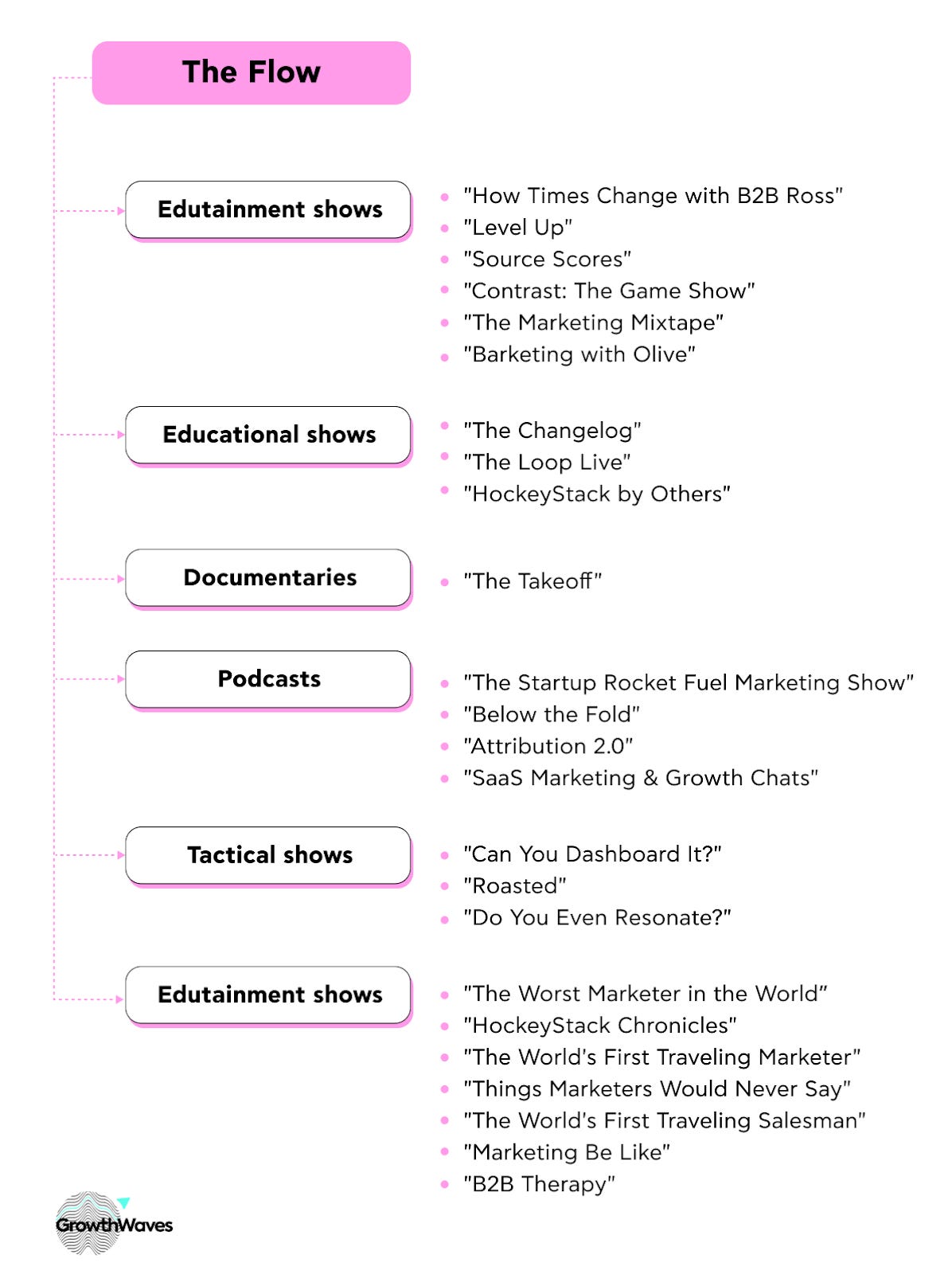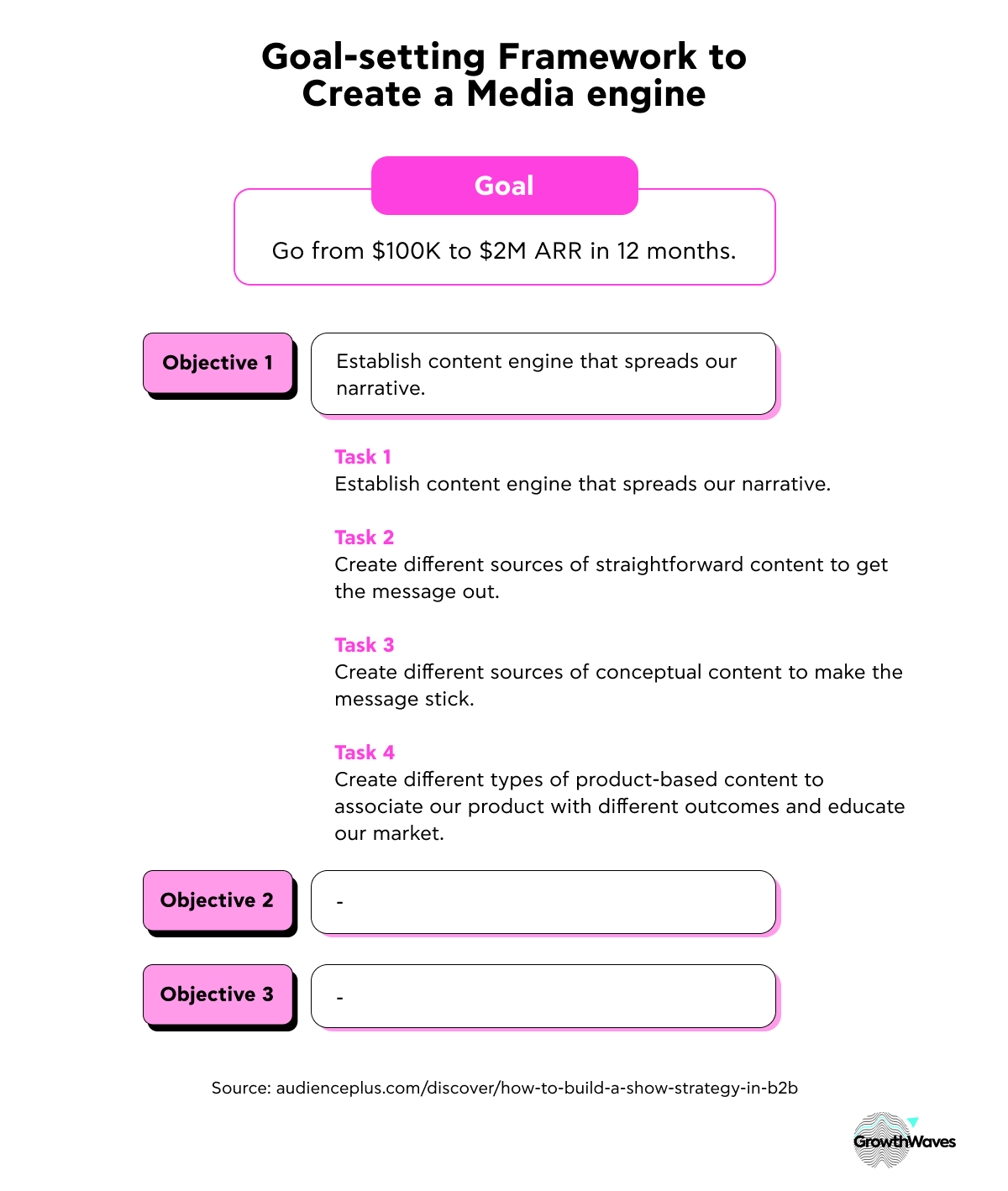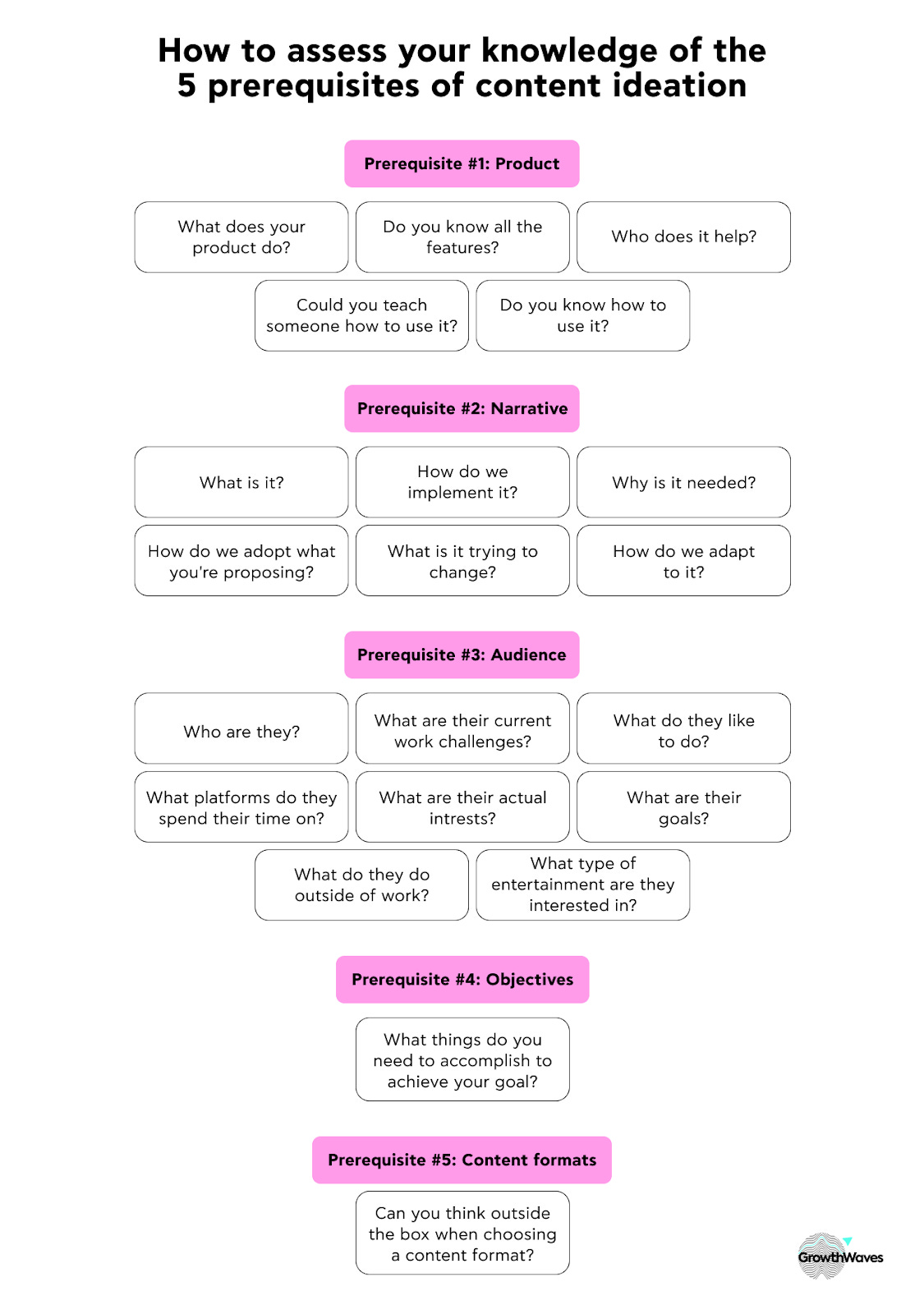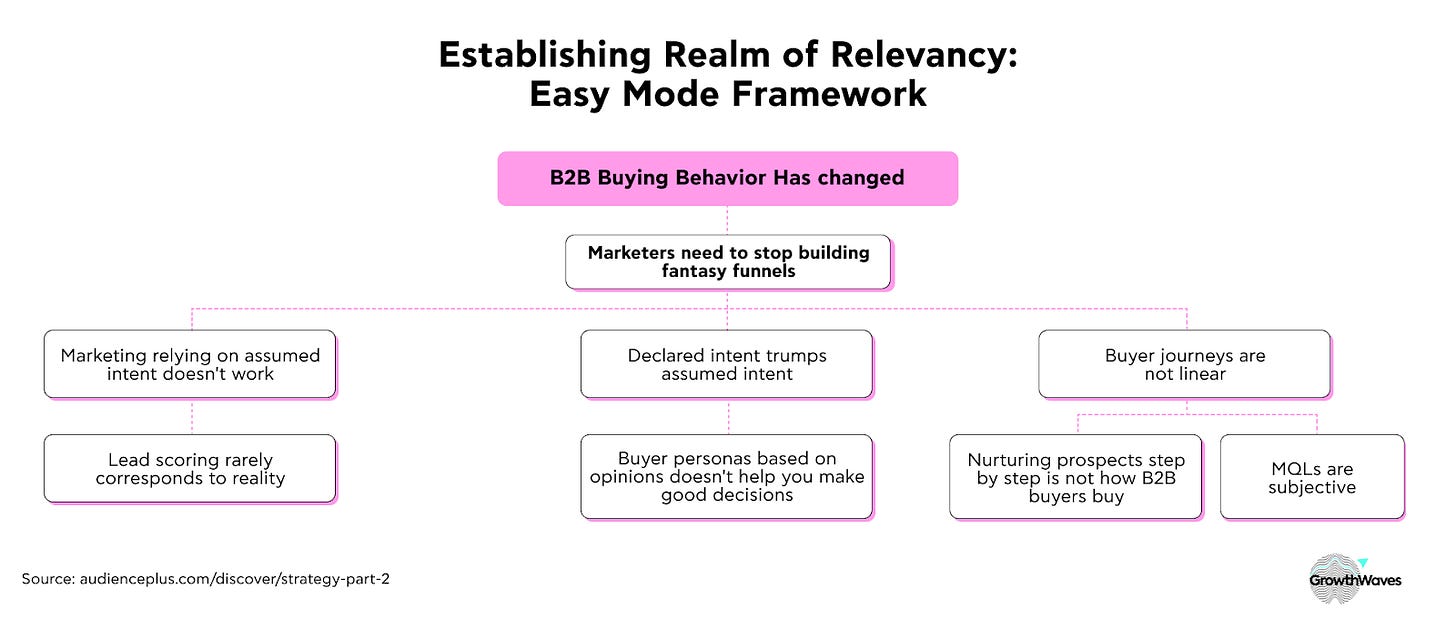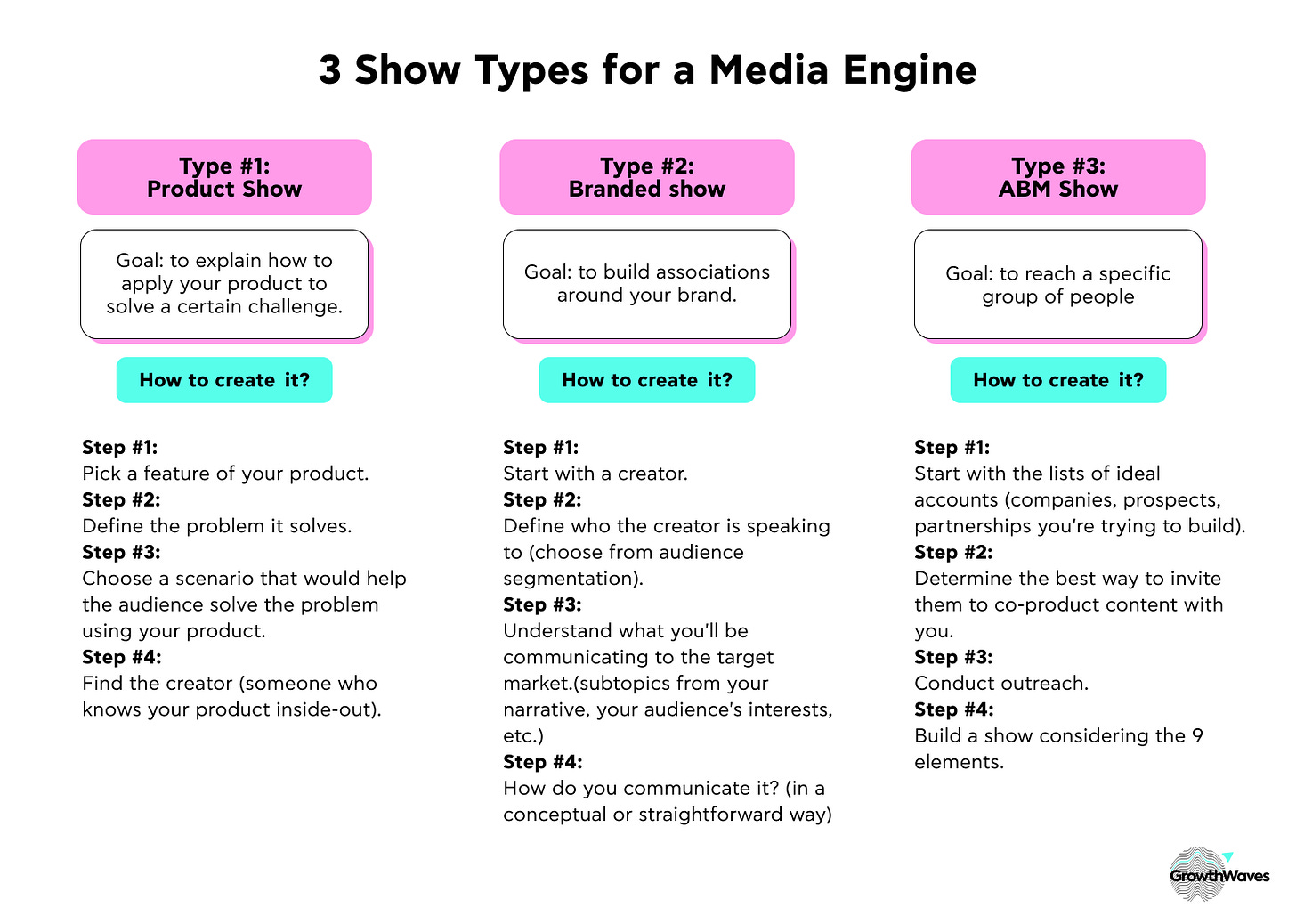The media asset that drove $8M in pipeline
Building a B2B streaming platform on a $3K budget
👋 Hey, I’m George Chasiotis. Welcome to GrowthWaves, your weekly dose of B2B growth insights—featuring powerful case studies, emerging trends, and unconventional strategies you won’t find anywhere else.
One-person content team.
3k monthly budget.
Is it possible to build something outstanding with such limited resources?
Obaid Durrani has proven that it is.
He managed to pull off a content strategy of 24 shows for The Flow, a streaming platform by HockeyStack, on a low budget.
In just 9 months, the platform drove more than $8M in pipeline.
How did he do it?
All the answers are in today’s GrowthWaves Note.
Key findings
Traditionally, we’ll start with the TL;DR of the Note.
The Flow launched in July 2023. Obaid was the main person behind its development.
The platform grew to 24 shows in 9 months. In October 2023 (just three months after the launch), it reached $6M in pipeline.
In spring 2024, The Flow grew to $8M in pipeline. Still, there wasn’t a large production team involved.
The Easy Mode Framework laid the foundation for The Flow. It was developed by Obaid Durrani and Todd Clouser and tested at Cognism, helping the brand build its own media engine.
So, what is this Easy Mode Framework about?
Can you apply it to achieve the same success?
Let’s find out.
The Flow by HockeyStack: Backstory
The Flow is a streaming platform run by HockeyStack, an inbound B2B sales optimization platform.

The Flow was launched on 19 July 2023 by Obaid Durrani, who joined the company in March of that same year.
However, Emir Atli, the co-founder and CRO at HockeyStack, conceptualized the idea for The Flow much earlier.
Here’s what Obaid shared during his interview with Tom Hunt for the Confessions of a B2B Entrepreneur podcast.
“(After Emir sent Obaid the link to The Flow) I went to it, and he (Emir) was already building out a streaming platform, and it was already in its infancy stage.”
So, there was already a playbook for The Flow, and it was almost identical to how Obaid wanted to do marketing at HockeyStack.
As Obaid shared with Tom Hunt,
“I wanted to push it a bit, build a streaming platform, and channel all our content through the series (of shows).”
And that he did.
Since he launched the platform in July 2023 and until he left HockeyStack on 20 March 2024, Obaid helped create a whopping 24 shows for The Flow.
You can see all of them in the graphic below.
And here’s a closer look at each show.
In less than a year, The Flow generated $8M+ in pipeline.
Impressive, right?
What’s even more inspiring is that there wasn’t a huge production team involved in the process.
Here’s what Obaid shared in his LinkedIn post.
“I grew HockeyStack from 0 to seven figures in 9 months and made one of the first B2B streaming platforms that drove $9M+ in pipeline. I did that on a $3K/month budget. I had an amazing salesperson, Nate, a great product, (and) a CS team that contributed to the ARR growth, but in terms of marketing, demand creation, brand building, content strategy, and creation, it was all me.”
This success was made possible thanks to the Easy Mode Framework.
Let’s break it down.
How to build a B2B dtreaming platform: Easy mode framework
A brief backstory first.
The Easy Mode Framework was ideated by Obaid Durrani and Todd Clouser, Marketing Advisor and Head of Audience Marketing at AudiencePlus.
Its goal is to help a brand launch a media asset.
They introduced the framework during the Cheat Codes by Easy Mode podcast and then turned it into a series on AudiencePlus.
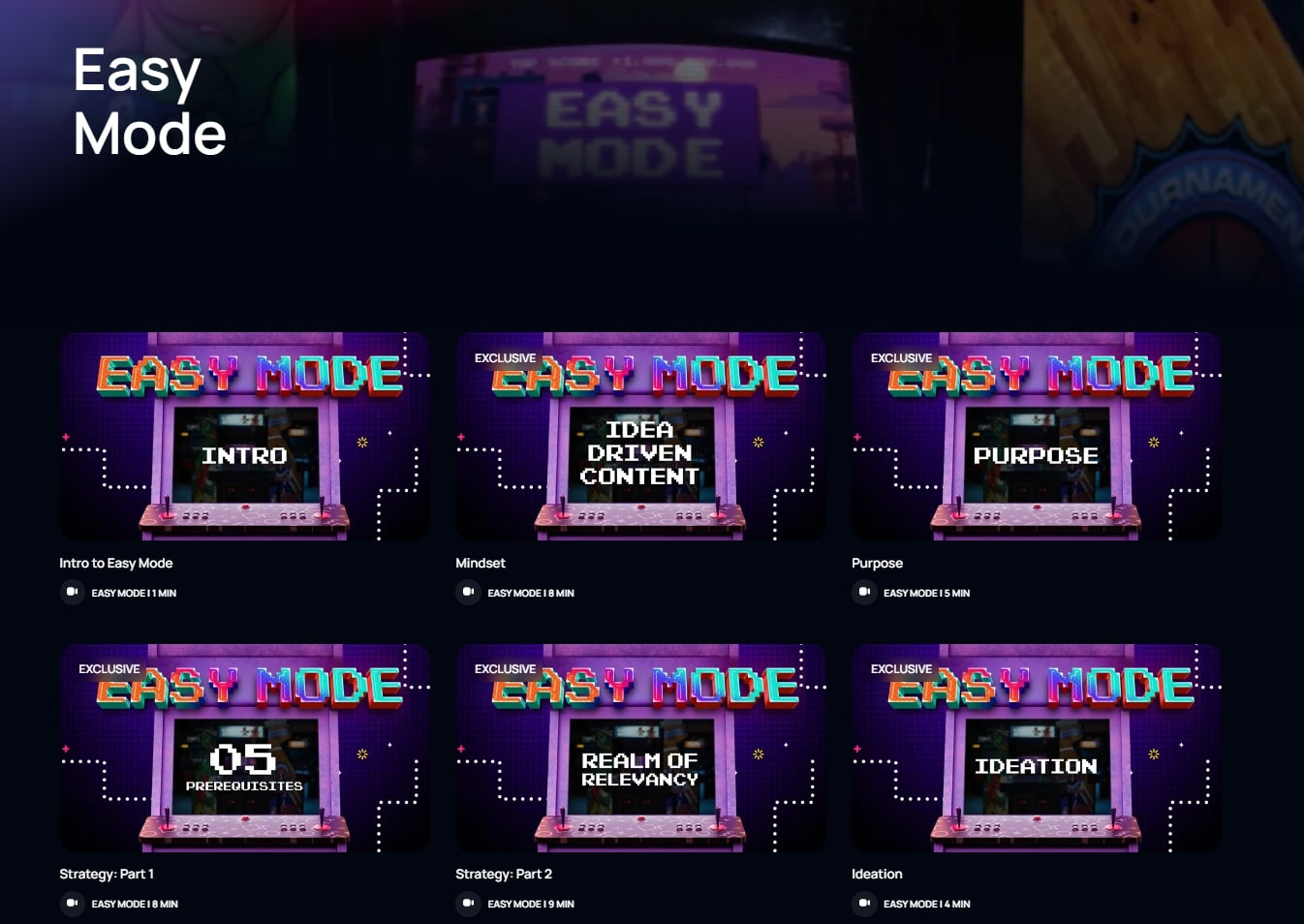
Obaid and Todd first tested the Easy Mode Framework at Cognism by launching the Content Hub, which included various resources, from newsletters and playbooks to podcasts.

As Obaid shared during the Confessions of a B2B Entrepreneur podcast, the framework proved highly effective.
“Fran (Fran Langham, Global Head of Demand Generation at Cognism) told me it (the framework) was super helpful, allowing the marketing department to drive alignment between everyone, thanks to the content engine they created.”
The same method laid the foundation of The Flow.
So, what’s it all about?
Here’s a brief overview of what the Easy Mode Framework entails.
Editor’s Note: The original Easy Mode Framework has a slightly different structure. This graph was adapted based on the Easy Mode series on AudiencePlus, Todd and Obaid’s speech at the GoldenHour 2024 conference, and Obaid’s LinkedIn posts to guide readers in launching their streaming platforms and B2B show strategies.
Let’s break it down.
Step #1: Adopting the “good content” mindset
The first three steps aim to help you build the foundation for your strategy.
With this one, in particular, the goal is to change your understanding of good content.
As Obaid shared in the first episode of the Easy Mode series on AudiencePlus,
“If you don’t know how to think about content, the audience won’t matter.”
So, how does the Easy Mode Framework define “good content?”
According to Obaid,
“Good content achieves whatever goal you set out for when you thought it up.”
In other words, such content fulfills the idea ingrained into it.
Obaid also calls it idea-driven content.
The framework breaks down idea-driven content into three types.
Insightful substance
Unique and interesting ways of presenting the insightful substance
Insightful substance, delivered through an interesting format and built on an entertaining concept
How do these content types differ from one another?
Here’s their overview.
The important part is that Type #1 content lays the foundation for Types #2 and #3.
However, it doesn’t mean they should be created in levels.
In fact, all of them should be equally present in your strategy.
According to Obaid,
“We call them types, not levels because when you start doing one, it doesn’t mean you stop doing the other. The best-performing media engines will incorporate and achieve a balance of all three types of content.”
Moving forward, anything you create within the lines of your owned media strategy should fall under one of these content types.
But how do you know which format to choose?
The answer lies in setting clear goals and objectives.
Step #2: Defining goals, objectives, and tasks
Creating a media engine requires joint effort from all departments involved (marketing, sales, customer service, etc.)
However, as Obaid mentioned during his speech at the GoldenHour 2024 conference, this effort often fails because all departments mostly work in silos.
“What you end up with is one marketing department, and within it, you have different groups that are working on different initiatives. And success for one team may or may not mean success for another team.”
How can you fix this?
According to Obaid, defining company goals can help create a universal strategy, bringing everyone’s contributions in alignment.
In his LinkedIn post, he suggests the following:
“Write down the 4 or 5 major goals that encompass the growth you're trying to achieve for (the given) interval (e.g., you're doing yearly planning, quarterly planning, etc.)”
Then, because there isn’t one way to achieve a goal, it makes sense to break it down into multiple objectives.
The final step is to break the objectives into tactics, defining the activities or tasks to accomplish the goal.
Altogether, the framework will look something like this (Obaid used this example during his GoldenHour 2024 speech).
The idea here is that, when you step back and examine the goals, objectives, and tasks you’ve outlined, you can spot the gaps and make adjustments based on what is missing.
For instance, the example above talks only about content creation, but no word is mentioned about distribution.
So, you’ll have to add more tasks to the objective to fill that gap.
With the goals set, you need to consider the purpose of the content for your media engine.
The answer to that lies in audience segmentation.
Step #3: Segmenting the audience
In episode two of the Easy Mode series on AudiencePlus, Todd Clouser talks about defining a purpose for your content.
According to him, the purpose lies in audience segmentation.
To define it, you need to ask yourself:
Who is your audience?
What do you want to happen when they consume your content?
As an answer to these questions, the Easy Mode Framework suggests three following segmentation variants:
Top-down strategic narrative
Middle-out implementation
Bottom-up evangelism
Each variant targets different audience segments and sets specific goals and purposes for the content to appeal to these target groups.
Here is their detailed breakdown.
So, essentially, the top-down narrative aims to create content that appeals to the leadership of your target organization.
If this content reaches its purpose, the leadership will push the implementation of your product on the employees who need help doing it.
That’s where middle-out implementation content comes in.
Finally, the bottom-up evangelism content aims:
To create a sense of belonging to something special for the existing users of your product;
To make non-users want to use your product.
The question is, what content out of the three types mentioned in the first step fits best for each of these purposes?
Here’s what Todd Clouser shared in the Easy Mode episode mentioned above:
“When it comes to the best content for the top-down (narrative), most teams choose to execute this through variations of Type #1 content. But well-executed Type #2 and Type #3 content to supplement that can be super effective.
As you think about executing the middle-out implementation content, think about it from all the different types discussed in the first step.
(For bottom-up evangelism) any type of content can be used, but this is where Type #2 and Type #3 can really shine.”
An example?
If we take The Flow, the top-down content would be the SaaS Marketing & Growth Chats podcast, which discusses the broader topic of growth but also involves HockeyStack’s own Emir Atli.
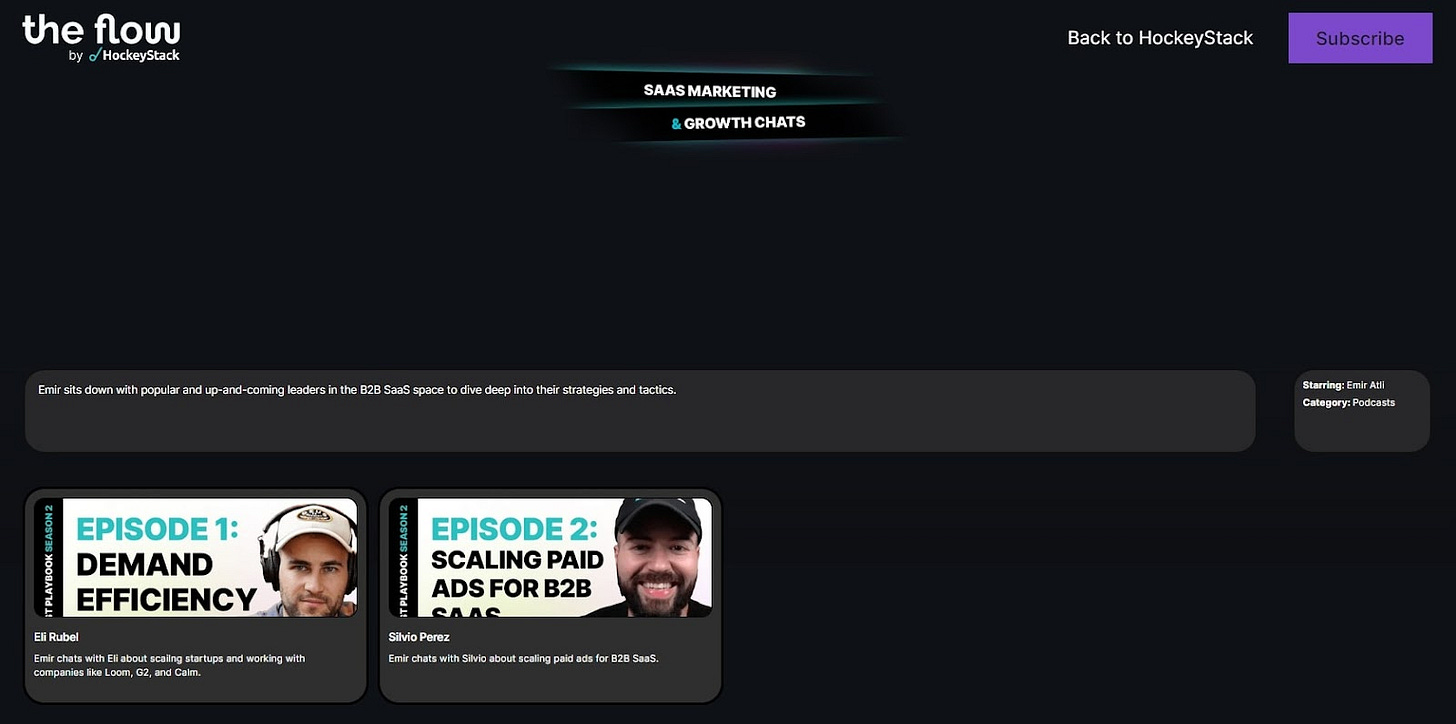
Can You Dashboard It is an excellent example of middle-out content, as it explains how to apply HockeyStack’s platform to different use cases.

Finally, a show like The Worst Marketer in the World can create a positive association with HockeyStack as a brand, fulfilling the purpose of the bottom-up content.

It’s important to note that how you prioritize these content types will depend on your company’s nature.
Todd Clouser gives the following recommendation:
“For most sales-focused companies, we recommend starting with top-down and working your way to bottom-up. But if you’re product-led and sell directly to end users, starting with bottom-up can be super effective.”
Defining the purpose lays the foundation for content ideation, which is the next step we’ll discuss.
Step #4: Doing content ideation
As I mentioned, changing the mindset about what good content means, outlining the goals, and defining your content’s purpose through audience segmentation lay the foundation for the next step—content creation.
According to the Easy Mode Framework, content creation starts with ideation, which includes two steps:
Checking if your idea passes the framework’s five prerequisites ideation;
Finding your realm of relevancy.
Let’s break them down.
5 Prerequisites of content ideation
In episode three of the Easy Mode series, Obaid highlights the following:
“The purpose of (these prerequisites) is to make it extremely easy for you to generate ideas that will impact your business goals.”
The idea is that if you feel stuck in the content ideation process, you lack the understanding of one (or several) of the following prerequisites:
To assess your knowledge of these prerequisites, Obaid recommends asking yourself the following questions:
According to Obaid, companies face challenges with content ideation the most because they don’t know how to associate their content idea with their product.
In his conversation with Tom Hunt, he implied that companies often entertain for the sake of being entertaining, which doesn’t lead to any tangible results.
“And so what happens is they (brands) create this ‘entertaining content,’ and you know, on the surface, it generates buzz, it grows their following across socials, but it never impacts revenue because they didn’t associate their products with any outcomes through that content.”
So, how do you build these associations?
In his LinkedIn post, Obaid suggests doing the following:
“1) Think of a goal you want to achieve with your content.
2) Think of different content formats you could create to achieve this goal.
3) Think of the message you want to deliver.
4) Tie it all together with a concept.”
The trick here is to casually build product associations.
As Obaid said in another LinkedIn post,
“To build (an) association with awareness, you need to subtly tie your product into the topic through relevance.”
And that’s what defining your realm of relevancy is all about.
Realm of relevancy
Realm of relevancy is your strategic narrative or the story you’re trying to tell your market.
Your strategic narrative is built on your:
Industry
Audience
Product
Vision
Objectives
Each strategic narrative can be broken down into POVs that will make up the list that you create your content on.
So, how can you define these POVs?
In the episode four of the Easy Mode series, Obaid suggests the following framework:
A strategic narrative includes three POVs reflecting your unique proposal (the beginning, middle, and end of your story).
Each POV includes three (or more) sparks that explain your points of view.
Each spark is broken down into several boxes with subject matter topics (SMs).
Finally, each subject matter topic (subtopic) includes multiple audience signals (three small dots next to each SM)—any type of feedback people have to your unique proposal.
And so, the goal of this breakdown is to help you tell your story level by level in a digestible manner.
An example?
In the Easy Mode episode mentioned above, Obaid shares how they created the realm of relevancy for Cognism, whose strategic narrative was “B2B buyers’ behavior has changed.”
The breakdown into POVs looked like this:
With this breakdown into POVs, sparks, and subject matter topics, you’ll have a list of topics for your content strategy.
Let’s talk about it next.
Step #5: Planning a content strategy
Based on what Obaid and Todd shared in their Easy Mode series and GoldenHour 2024 speech, a content strategy for a media engine includes the following steps:
Let’s discuss these steps in detail.
1. Shaping your message
Your message gives structure to your content.
So, the first step is to figure out how to formulate it.
In episode five of the Easy Mode series, Todd Clouser provides the following framework for this task:
Essentially, you take the goal, formulate it into a message, and choose a format, which will encourage your audience to act on your message.
Here’s a more detailed look at this framework with examples:
With this done, you can move on to the next step.
2. Choosing content types
Once you formulate your message, it will be easier to determine the content type that best communicates it.
The Easy Mode Framework offers two such content types:
Straightforward
Conceptual
Here’s a closer look at them.
In most cases, you will need to include both content types.
As Obaid said in his LinkedIn post,
“You create straightforward, informative content to get your message out there.
And you create conceptual, enjoyable content to make that message stick.”
In that same post, he mentions that he used the mix of both to launch a new feature of HockeyStack’s platform to make it both informative and entertaining:
Straightforward content: a launch video announcing the release, text posts, and “talking head” videos about the new feature.
Conceptual content: skits on relatable scenarios associated with HockeyStack.
Next, you’ll need to choose a content format.
For this, you’ll have to consider three content areas.
3. Choosing a content area
You can create straightforward and conceptual content around three following areas:
Product
Narrative
Your brand
Which of the two content types will best fit each area?
Here’s what I was able to pull together based on Obaid’s appearance in Hubilo’s WTF News.
In that same episode, Obaid mentions that many brands focus too much on creating content around product and narrative.
Yet, they completely disregard content around the brand, which is just as important.
“The whole point of this content is that people think of you when they move in-market for a solution like yours. However, they won’t think of you if they don’t associate you with (a particular) outcome, which defeats the purpose of creating this type of content in the first place.”
So, the balanced presence of content around all three areas is crucial.
The question is, how are you going to present it?
4. Finding creators
When launching The Flow, Obaid chose both internal (from HockeyStack) and external creators, which he recommends everyone does.
As he mentioned in his post:
“You can have folks within your company (like yourself, others on the marketing team, senior leadership, etc.) create content and episodic shows.
You can also contract content creators and SMEs from your industry to create Straightforward and Conceptual product-based, narrative-based, and branded content, or episodic shows.”
For example, Obaid involved Nate Branscome, HockeyStack’s go-to-market manager, in filming the episodes for Can You Dashboard It?, and Tim Davidson from B2B Rizz played B2B Ross in the How Times Change series.
How to choose the right creator?
As for in-house evangelists, Obaids recommends focusing on the following traits in his LinkedIn post:
“- They need to have a solid content/copywriting foundation.
- They need to have some experience with video content or be comfortable with the idea of creating video content/showing up on camera.
- They need to have the ability to coach other team members.”
When choosing an outside creator, target those with relevant following and whose vision aligns with yours.
Obaid suggests luring them in with the following tactics:
“1. Give them a product demo.
2. Share your goals with them.
3. Share your narrative with them.
4. Understand the type of content they enjoy making.
5. Understand the type of content their audience expects from them.
6. Ideate a content series for them that will help you communicate your messages to your market AND be the content their audience will enjoy.”
Now, to have both inside and outside creators help you achieve your business objectives, you’ll need several show formats to add to your media engine.
Let’s talk about that.
Step #6: Choosing show formats
With goals, objectives, realm of relevancy, and other components settled, you can now ideate the concepts for your B2B shows.
According to Todd and Obaid, to understand which show format will best serve a given objective, you need to consider the following nine elements.
With these elements outlined, you can start drafting the first show for your media engine.
However, Todd and Obaid recommend not aiming too high at first and starting with low-effort content.
Here’s why.
“As you’re creating all this content, the biggest objection you’re going to get is that it takes too much time, budget, and resources.”
So, it’s better to start low and prove the concept resonates with the audience.
If your low effort pays off, it makes sense to invest more resources if needed. (You don’t have to do it if your current effort already brings good results.)
But whether you have resources for high effort or not, you can still create the following show types, which Obaid and Todd presented during their GoldenHour 2024 speech.
What is the best order to follow when creating these show types?
Obaid recommends starting with a product show.
Then, based on his experience, you should launch three branded shows.
Finally, create an ABM show.
From there, you want to create a balance between the types, involve people from inside and outside your organization (preferably with a following), and distribute these shows as regularly scheduled programming.
The goal is to make your shows memorable and make them stick in the minds of your target audience.
Conclusion
Quite an interesting approach to creating a media engine, right?
The framework behind The Flow may seem a bit involved, but it really helps you think and plan through the entire content strategy.
But what I find the most interesting is that it encourages you to change your mindset about what good content means.
This is a crucial prerequisite to consider because changing your perspective on good content opens your mind to out-of-the-box formats, which can really facilitate the growth of your media engine.
See you next week!


